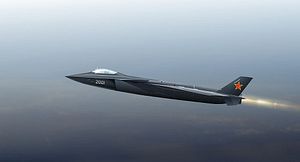The People’s Liberation Army Air Force’s (PLAAF) first fifth-generation fighter aircraft, the Chengdu Aerospace Corporation (CAC) J-20 multirole fighter, will soon move into serial production, according to a October 23 broadcast on China Central TV’s (CCTV) Channel 4, IHS Jane’s Defence Weekly reports.
The broadcast showed five J-20s flying in formation.
“According to the CCTV report, the aircraft has entered what is referred to as ‘stable’ mass production, which is interpreted as meaning there is now a fixed, regular production rate in order to create some minimal economies of scale,” Jane’s reports.
In September, a spokesperson for the Chinese Ministry of National Defense announced that the J-20 has been officially commissioned into military service. The PLAAF is the second air force in the world to operate a fifth-generation fighter aircraft after the United States.
As I noted elsewhere:
The twin-engine fighter, built by Chengdu Aerospace Corporation, is a single seat stealth fighter designed for long-range fighter missions such as attacking support aircraft including tankers with PL-12 beyond visual range air-to-air missiles (BVRAAM).
A special testing unit of the PLAAF has been flying the J-20A for over a year. As I reported in March, China Central Television (CCTV) video footage showed a number of J-20A stealth fighters flying alongside H-6K long-range bombers and Xian Y-20 large military transport aircraft participating in a military exercise.
It is unknown how many J-20 have been handed over to the PLAAF so far for testing. Estimates vary from six to 13 (eight J-20As prototypes and five low rate initial production fighter jets). According to Jane’s, the J-20 will likely enter service with the PLAAF before achieving full operational capability.
The J-20 still lacks a reliable indigenously made jet engine. As I explained last month:
Chinese military sources have repeatedly pointed out some of the difficulties the program is still facing. “There are still a series of technical problems that need to be tackled [on the J-20], including the reliability of its WS-15 engines, [and the plane’s] control system, stealth coat and hull materials and infrared sensor,” a Chinese military official told the South China Morning Post in March.
Considerable doubts remain over the aircraft’s capabilities. “It is (…) unclear whether the J-20 can match the radar-evading capabilities of the Lockheed Martin F-22 Raptor stealth fighter aircraft or the F-35 Lightning II fighter,” I explained previously. “Given that the aircraft apparently lacks thrust vectoring, it is likely less maneuverable than American-made fifth-generation warplanes.”
China expects to produce up to three J-20 aircraft per month once the program enters serial production. CAC plans to produce up to 100 J-20s by the end of 2020.
































